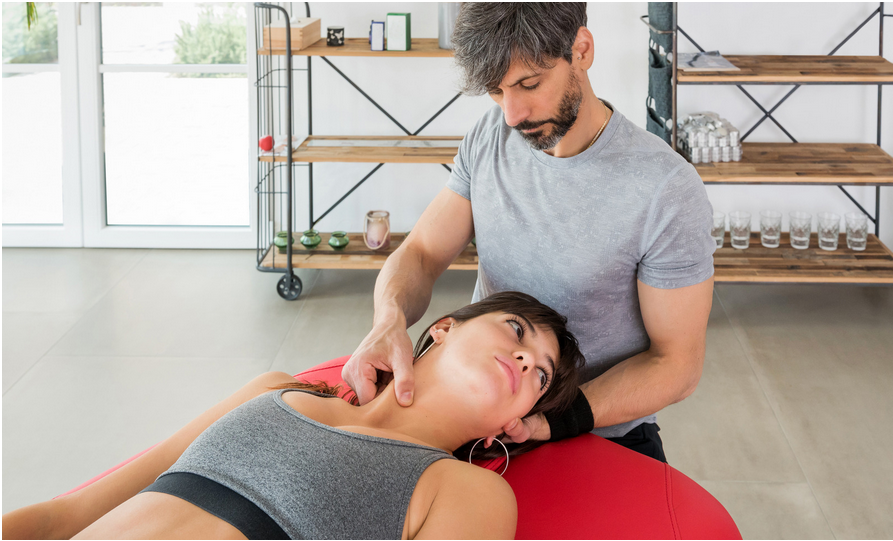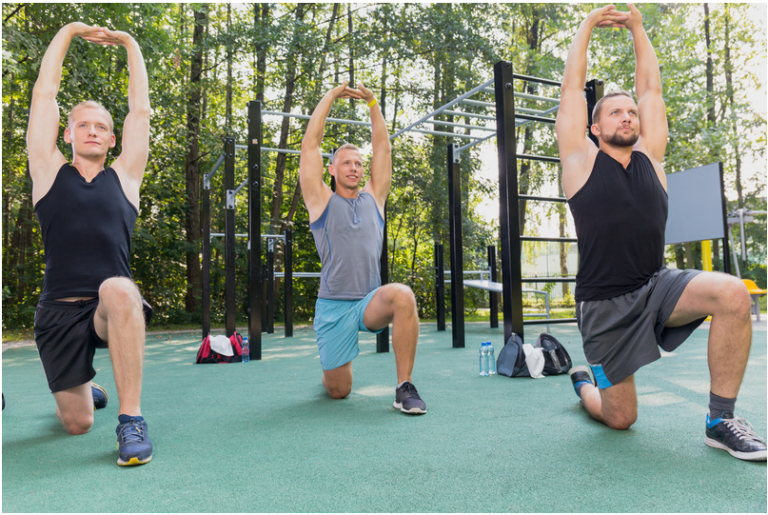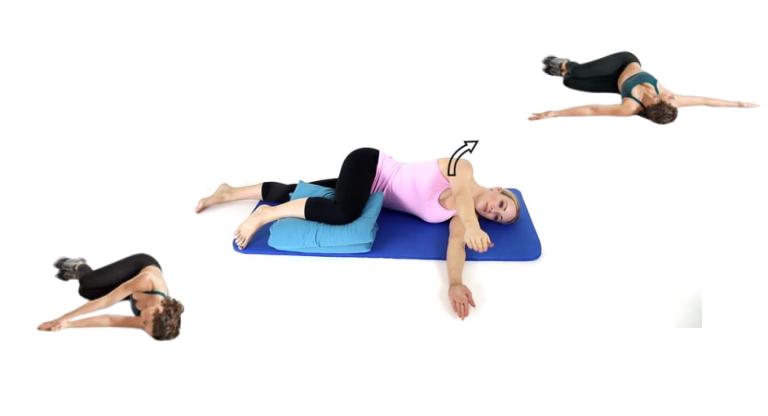
Stretching Sternocleidomastoid Muscle | Guide for Better Posture and Neck Pain Relief

The sternocleidomastoid (SCM) muscle is one of the most important muscles in your neck. It runs from the base of your skull, behind your ear, to your collarbone. It helps you tilt and turn your head and flex your neck forward.
However, the SCM muscle can also become tight, overactive, and sore due to poor posture, stress, injury, or overuse. A tight SCM muscle can lead to neck pain, stiffness, headaches, a reduced range of motion, and forward head posture.
That’s why stretching your SCM muscle regularly is important, especially if you spend a lot of time sitting, working on a computer, or looking at your phone. Stretching your SCM muscles can help relieve tension, improve posture, and prevent neck pain.
In this article, you’ll learn how to stretch your SCM muscle safely and effectively using simple exercises that you can do at home or in the office. You’ll also learn how to identify and correct common SCM muscle problems and maintain a healthy and balanced neck.
What is the SCM muscle, and why is it important?

The SCM muscle is a long and thin muscle that attaches to the mastoid process (a bony bump behind your ear) and the clavicle (collarbone). It has two parts: the sternal head, which connects to the sternum (breastbone), and the clavicular head, which connects to the clavicle.
The SCM muscle has several functions, such as:
- Flexing your neck forward (chin to chest)
- Tilting your head to the side (ear to shoulder)
- Rotating your head to the opposite side (looking over your shoulder)
- Assist in breathing by lifting your chest.
The SCM muscle is also involved in many movements and activities, such as:
- Driving
- Reading
- Sleeping
- Talking
- Swallowing
- Chewing
- Singing
As you can see, the SCM muscle is very active and important for your neck’s health and function. However, it can also become problematic if it’s not stretched and cared for properly.
What causes a tight SCM muscle?

A tight SCM muscle can be caused by various factors, such as:
- Poor posture: If you slouch, hunch, or lean forward, you put excessive strain on your SCM muscle, which can cause it to shorten and tighten over time. This can also lead to forward head posture, where your head juts out in front of your body, creating more tension and imbalance in your neck.
- Stress: If you’re stressed, anxious, or tense, you may unconsciously clench your jaw, shrug your shoulders, or hold your breath, which can activate and tighten your SCM muscle. This can also affect your blood flow, oxygen delivery, and nerve function in your neck.
- Injury: If you suffer a trauma, such as a whiplash, fall, or blow to the head, you may injure your SCM muscle, causing inflammation, pain, and spasms. This can also affect your alignment, stability, and mobility in your neck.
- Overuse: If you perform repetitive or prolonged activities that involve your SCM muscle, such as driving, reading, or working on a computer, you may overwork and fatigue your SCM muscle, causing it to become sore and tight. This can also reduce your flexibility, strength, and coordination in your neck.
A tight SCM muscle can have various consequences, such as:
- Neck pain: A tight SCM muscle can cause pain in your neck, especially on the side where the muscle is tight. The pain may be dull, aching, or sharp and radiate to your head, shoulder, or arm. The pain may also worsen with movement, such as turning or tilting your head.
- Reduced range of motion: A tight SCM muscle can limit your ability to move your neck freely, such as looking up, down, or side to side. This can affect your daily activities, such as driving, working, or exercising.
- Headaches: A tight SCM muscle can trigger headaches, especially on the side where the muscle is tight. The headaches may be tension-type, where you feel a band of pressure around your head, or carcinogenic, where you feel pain in the back, behind your eye, or in your temple. The headaches may also be accompanied by nausea, dizziness, or sensitivity to light or sound.
- Forward head posture: A tight SCM muscle can contribute to forward head posture, where your head juts out in front of your body, creating a hunched appearance. This can affect your appearance, confidence, and self-esteem, as well as your posture, alignment, and balance in your whole body.
How to Stretch Your SCM Muscle
Stretching your SCM muscle can help loosen and lengthen the muscle, relieving tension, pain, and stiffness. Stretching your SCM muscle can also improve your posture, alignment, and range of motion in your neck and prevent further problems and injuries.
Here are some simple and effective stretches that you can do to stretch your SCM muscle. You can do these stretches at home or in the office using a chair, a wall, or a towel. You can also watch this stretch video to demonstrate the stretches visually.
Before you start, make sure you:
- Warm up your neck gently, such as nodding, shaking, or rolling your head.
- Sit straight with your shoulders back and down and your feet flat on the floor.
- Breathe deeply and relax your jaw, shoulders, and neck.
- Stretch gently and slowly without bouncing or forcing the movement.
- Hold each stretch for about 30 seconds, and repeat 2 to 3 times per side.
- Feel a mild to moderate stretch but no pain or discomfort. If you feel pain, stop or modify the stretch.
- Stretch both sides of your neck, even if only one side is tight or sore.
Stretch 1: Neck Tilt

This stretch targets the sternal head of the SCM muscle, which attaches to the sternum.
- Sit up tall and look straight ahead.
- Tilt your head to the right, bringing your right ear towards your right shoulder. Keep your left shoulder down and relaxed.
- You should feel a stretch on the left side of your neck.
- Place your right hand on the left side of your head to increase the stretch and gently apply some pressure. Don’t pull or push your head; just let the weight of your hand assist the stretch.
- Hold for 30 seconds, then switch sides.
Stretch 2: Neck Rotation
This stretch targets the clavicular head of the SCM muscle, which attaches to the clavicle.
- Sit up tall and look straight ahead.
- Gently turn your head to the right, looking over your right shoulder. Keep your shoulders level and relaxed.
- You should feel a stretch on the left side of your neck.
- Place your right hand on the left side of your chin to increase the stretch and gently apply some pressure. Don’t pull or push your head; just let the weight of your hand assist the stretch.
- Hold for 30 seconds, then switch sides.
Stretch 3: Neck Flexion
This stretch targets both heads of the SCM muscle and other neck muscles.
- Sit up tall and look straight ahead.
- Gently tuck your chin towards your chest as if you’re making a double chin. Keep your shoulders back and down and your spine straight.
- You should feel a stretch on the back of your neck.
- You can place both hands on the back of your head to increase the stretch and gently apply some pressure. Don’t pull or push your head; just let the weight of your hands assist the stretch.
- Hold for 30 seconds, then release.
Stretch 4: Neck Extension
This stretch targets the front of the neck, including the SCM muscle.
- Sit up tall and look straight ahead.
- Gently tilt your head back, looking up at the ceiling. Keep your shoulders down and relaxed and your mouth closed.
- You should feel a stretch on the front of your neck.
- You can place both hands on your forehead and gently apply some pressure to increase the stretch. Don’t pull or push your head; just let the weight of your hands assist the stretch.
- Hold for 30 seconds, then release.
Stretch 5: Neck Retraction
This stretch helps correct forward head posture, which can cause or worsen SCM muscle tightness.
- Sit up tall and look straight ahead.
- Pull your head back as if trying to make a double chin. Keep your chin parallel to the floor and your eyes level. Don’t tilt or turn your head.
- You should feel a gentle tension on the front of your neck and a slight lengthening on the back.
- Hold for 5 seconds, then relax. Repeat ten times.
Stretch 6: Neck Massage
This stretch helps release tension and knots in the SCM muscle and improves blood flow and oxygen delivery to the muscle.
- Sit up tall and look straight ahead.
- Locate your SCM muscle by placing your fingers on your sternum and sliding them up along the side of your neck until you feel a thick and rope-like muscle.
- Gently pinch the muscle between your thumb and index finger, and slide your fingers up and down the muscle, applying moderate pressure. You may feel some tender or sore spots, which indicate tightness or trigger points.
- Massage the muscle for about 10 minutes or until you feel some relief. You can also use a massage tool, such as a tennis ball, a foam roller, or a massage stick, to apply pressure to the muscle.
- Repeat the massage on the other side of your neck if needed.
Stretch 7: Neck Roll
This stretch helps relax and mobilize the SCM muscle and other neck muscles.
- Sit up tall and look straight ahead.
- Slowly roll your head to the right, bringing your chin towards your right shoulder. Keep your shoulders down and relaxed.
- Slowly roll your head back, looking up at the ceiling. Keep your mouth closed and your spine straight.
- Slowly roll your head to the left, bringing your chin towards your left shoulder. Keep your shoulders down and relaxed.
- Slowly roll your head forward, tucking your chin towards your chest. Keep your shoulders back and down and your spine straight.
- Repeat the roll in the opposite direction, starting from the left side.
- Do the roll five times in each direction, moving slowly and smoothly.
How to Prevent SCM Muscle Tightness
Stretching your SCM muscle can help relieve and prevent SCM muscle tightness, but it’s also important to address the root causes of the problem, such as poor posture, stress, injury, or overuse. Here are some tips to prevent SCM muscle tightness:
- Maintain good posture: Whether sitting or standing, keep your head aligned with your spine, your chin parallel to the floor, and your eyes level. Avoid slouching, hunching, or leaning forward, which can strain your SCM muscle. Use a supportive chair, pillow, or ergonomic device to help you maintain good posture.
- Take breaks: If you spend a lot of time in a fixed position, such as working on a computer, driving, or reading, take frequent breaks to move your neck and body. Change your position, stretch your neck, and do shoulder rolls every 15 to 30 minutes. This can help prevent stiffness, fatigue, and tension in your SCM muscle.
- Manage stress: Stress can cause you to tense up your jaw, shoulders, and neck, which can activate and tighten your SCM muscles. Try to reduce or cope with stress by using relaxation techniques such as deep breathing, meditation, yoga, or massage. You can also seek professional help, such as counseling, therapy, or medication if you have chronic or severe stress.
- Avoid injury: If you have a history of neck injury, such as a whiplash, fall, or blow to the head, be careful when moving your neck. Avoid sudden or jerky movements, and use a neck brace or collar if prescribed by your doctor. You can also do gentle exercises to strengthen and stabilize your neck, such as chin tucks, shoulder blade squeezes, or neck rotations. Consult your doctor or physical therapist before starting any exercise program.
- Seek medical advice: If you have persistent or severe SCM muscle tightness, pain, discomfort, or other symptoms, such as numbness, tingling, weakness, or dizziness, see your doctor or physical therapist as soon as possible. You may have an underlying condition, such as a herniated disc, a pinched nerve, or an infection that requires medical attention. Don’t ignore or self-treat your symptoms, as they may worsen or lead to complications.
Summary
The SCM muscle is vital in your neck and helps you move your head and neck. However, it can also become tight, overactive, and sore due to various factors, such as poor posture, stress, injury, or overuse. A tight SCM muscle can cause neck pain, stiffness, headaches, a reduced range of motion, and forward head posture.
To stretch your SCM muscle, you can do the following exercises:
- Neck tilt: Tilt your head to the side, bringing your ear towards your shoulder.
- Neck rotation: Turn your head to the side, looking over your shoulder.
- Neck flexion: Tuck your chin towards your chest, making a double chin.
- Neck extension: Tilt your head back, looking up at the ceiling.
- Neck retraction: Pull your head back, making a double chin.
- Neck massage: pinch and slide your fingers along the SCM muscle, applying moderate pressure.
- Neck roll: Roll your head in a circular motion, moving slowly and smoothly.
To prevent SCM muscle tightness, you should also:
- Maintain good posture: keep your head aligned with your spine, your chin parallel to the floor, and your eyes level.
- Take breaks: Move your neck and body every 15 to 30 minutes, changing your position and stretching your neck.
- Manage stress: Use relaxation techniques, such as deep breathing, meditation, yoga, or massage, to reduce or cope with stress.
- Avoid injury: Be careful when moving your neck, and use a neck brace or collar if prescribed by your doctor.
- Seek medical advice. See your doctor or physical therapist if you have persistent or severe SCM muscle tightness, pain, discomfort, or other symptoms, such as numbness, tingling, weakness, or dizziness.
By stretching and caring for your SCM muscle, you can improve your neck health and function and your posture, alignment, and balance in your whole body. You can also prevent and relieve neck pain, stiffness, headaches, and other problems. Try these stretches today, and feel the difference in your neck.
References
- The effects of combined sternocleidomastoid muscle stretching and massage on pain, disability, endurance, kinesiophobia, and range of motion in individuals with chronic neck pain: A randomized, single-blind study. This study found that stretching and massage applied to the SCM muscle and conventional physiotherapy can reduce pain and disability and increase range of motion and endurance in individuals with chronic neck pain. 1
- Sternocleidomastoid Stretch: Relieve Neck Stiffness and Improve Posture. This article provides a detailed guide on how to stretch the SCM muscle and the benefits and precautions of doing so. It also explains the anatomy and function of the SCM muscle and the causes and consequences of SCM muscle tightness. 2
- The Best Sternocleidomastoid Stretches for Neck Flexibility. This article offers some of the best stretches for the SCM muscle and tips on how to perform them correctly and safely. It also discusses the importance of stretching the SCM muscle to improve neck flexibility and posture. 3



